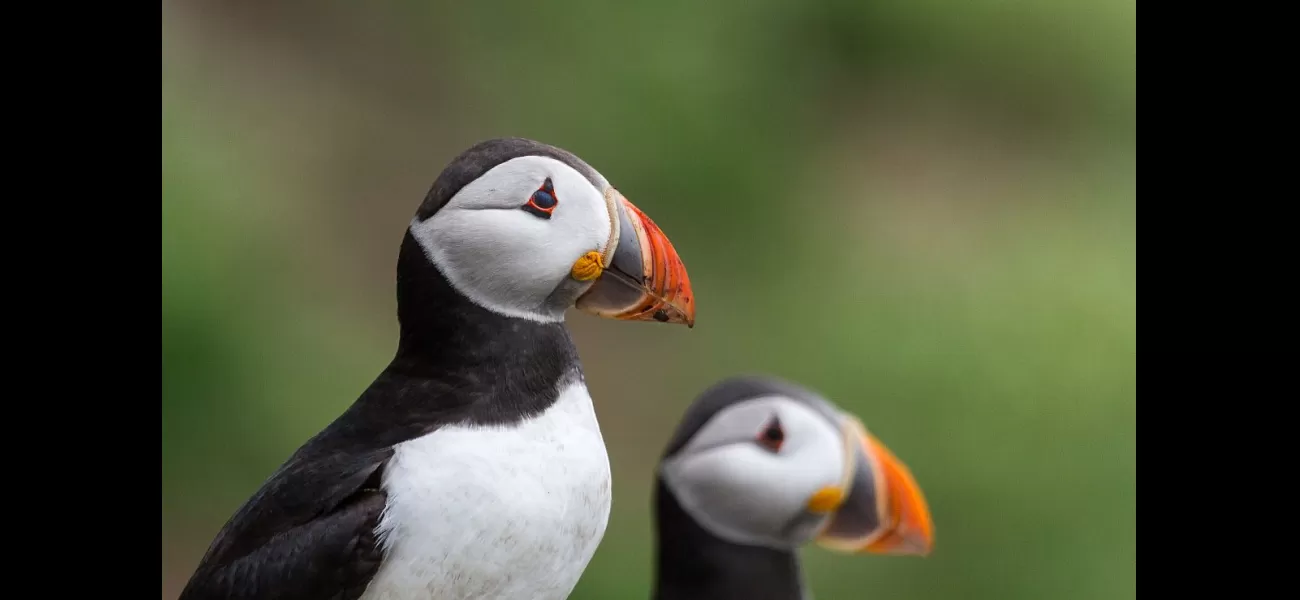The population of puffins at Isle of May, one of UK's biggest colonies, has grown by 33%.
Puffin numbers at UK's Isle of May have risen by 33% since 2017, with an estimated 52,000 occupied burrows.
June 14th 2024.

According to experts, the population of puffins at one of the UK's largest colonies on the Isle of May has increased by approximately one third since 2017. This exciting news was revealed by scientists who estimate that there are now around 52,000 occupied puffin burrows on the island's nature reserve. This is a significant increase from the last survey conducted in 2017, which recorded 39,000 occupied burrows, representing a 33% rise in numbers.
The research, conducted by the UK Centre for Ecology & Hydrology in collaboration with NatureScot, also highlights ongoing concerns about the impact of food supplies and climate change on puffin populations. The Isle of May National Nature Reserve, situated in the Firth of Forth, is not only a protected area but also an internationally important habitat for seabirds. It is home to an estimated 100,000 puffins, as well as tens of thousands of other birds such as shags, guillemots, razorbills and kittiwakes.
David Steel, manager at the nature reserve, expressed his delight at the news, stating that people from all over the world come to see the iconic Isle of May puffins, making this increase in population truly fantastic. He also acknowledged the multiple challenges faced by seabirds across the UK, including marine heatwaves, climate change, and outbreaks of bird flu in recent years, making this increase in numbers all the more significant.
The UKCEH has been monitoring colonies on the Isle of May for 50 years, and their long-term research has shown that puffins, like many other species, are struggling with the impacts of climate change. Despite the good news, Mark Newell, UKCEH's field manager on the island, cautions that this increase in numbers may mask a recent decline in the species. He explains that they have been following a small colony of birds fitted with identification rings for the past few years, and the numbers seen have been below average in the last two years. However, he believes that the population may have increased substantially since the last count in 2017, following a period of high breeding success and survival.
Rising ocean temperatures have been identified as a potential threat to puffins, as they can reduce the availability of their food sources, particularly sandeels. This, in turn, affects their survival rates and ability to produce offspring. The recent occurrence of heavy storms has also resulted in the death of many birds, but there is no evidence to suggest that bird flu has been a problem for puffins on the Isle of May.
Some interesting facts about puffins include that their offspring are called pufflings and they spend the first three years of their lives entirely at sea. During the breeding season, females lay a single egg in the same burrow every year, and they begin breeding at around five years old and mate for life. Puffins can live up to 20 years, with the oldest recorded individual living to the ripe old age of 42. These beautiful birds can be found in various regions, including the UK, Ireland, Iceland, Norway, Russia, and Canada. They are also part of the auk family, which includes other species like guillemots and razorbills.
To learn more about wildlife and conservation efforts, check out more stories here and subscribe to Scottish Field for the latest issue.
The research, conducted by the UK Centre for Ecology & Hydrology in collaboration with NatureScot, also highlights ongoing concerns about the impact of food supplies and climate change on puffin populations. The Isle of May National Nature Reserve, situated in the Firth of Forth, is not only a protected area but also an internationally important habitat for seabirds. It is home to an estimated 100,000 puffins, as well as tens of thousands of other birds such as shags, guillemots, razorbills and kittiwakes.
David Steel, manager at the nature reserve, expressed his delight at the news, stating that people from all over the world come to see the iconic Isle of May puffins, making this increase in population truly fantastic. He also acknowledged the multiple challenges faced by seabirds across the UK, including marine heatwaves, climate change, and outbreaks of bird flu in recent years, making this increase in numbers all the more significant.
The UKCEH has been monitoring colonies on the Isle of May for 50 years, and their long-term research has shown that puffins, like many other species, are struggling with the impacts of climate change. Despite the good news, Mark Newell, UKCEH's field manager on the island, cautions that this increase in numbers may mask a recent decline in the species. He explains that they have been following a small colony of birds fitted with identification rings for the past few years, and the numbers seen have been below average in the last two years. However, he believes that the population may have increased substantially since the last count in 2017, following a period of high breeding success and survival.
Rising ocean temperatures have been identified as a potential threat to puffins, as they can reduce the availability of their food sources, particularly sandeels. This, in turn, affects their survival rates and ability to produce offspring. The recent occurrence of heavy storms has also resulted in the death of many birds, but there is no evidence to suggest that bird flu has been a problem for puffins on the Isle of May.
Some interesting facts about puffins include that their offspring are called pufflings and they spend the first three years of their lives entirely at sea. During the breeding season, females lay a single egg in the same burrow every year, and they begin breeding at around five years old and mate for life. Puffins can live up to 20 years, with the oldest recorded individual living to the ripe old age of 42. These beautiful birds can be found in various regions, including the UK, Ireland, Iceland, Norway, Russia, and Canada. They are also part of the auk family, which includes other species like guillemots and razorbills.
To learn more about wildlife and conservation efforts, check out more stories here and subscribe to Scottish Field for the latest issue.
[This article has been trending online recently and has been generated with AI. Your feed is customized.]
[Generative AI is experimental.]
0
0
Submit Comment





